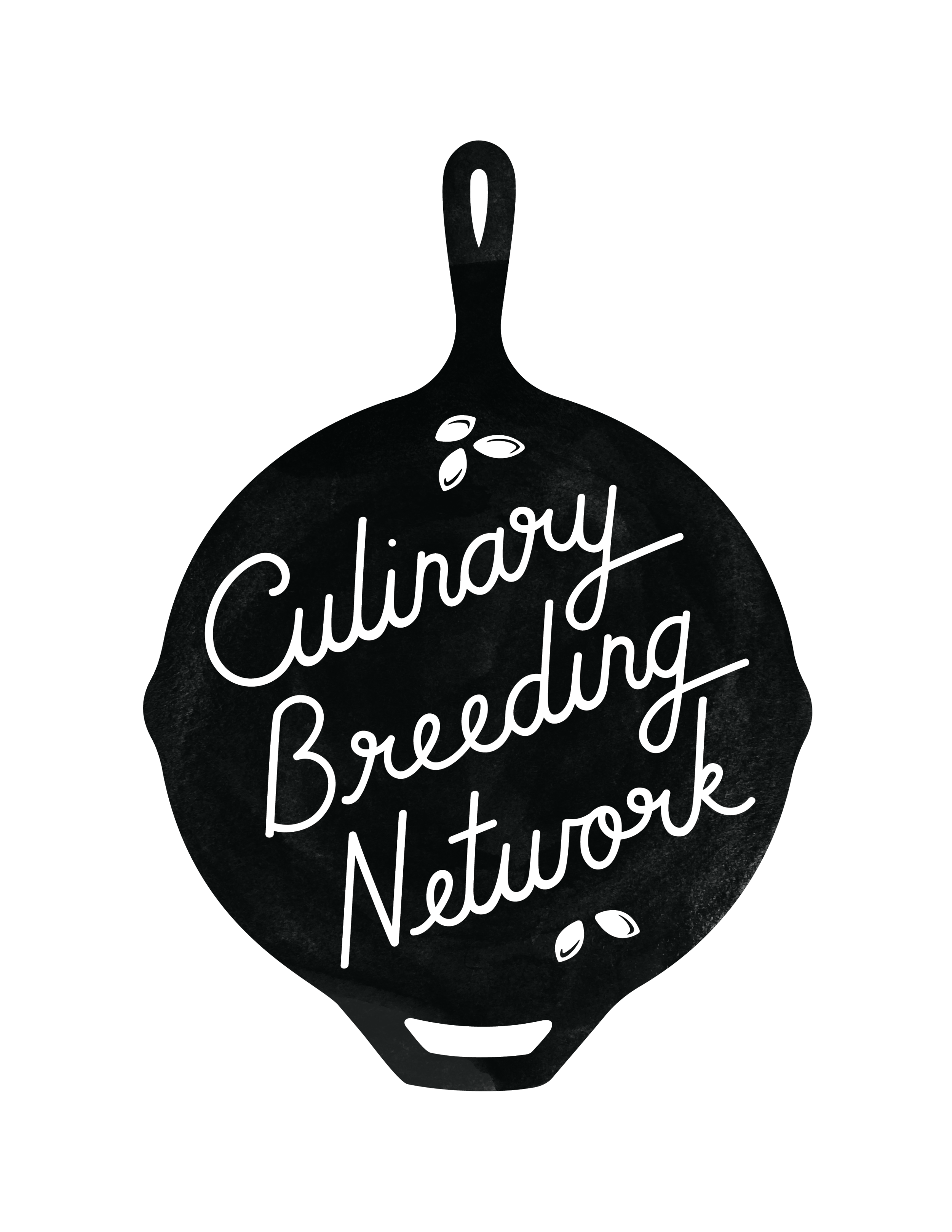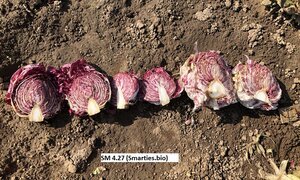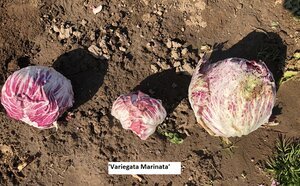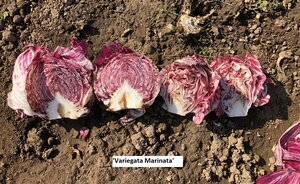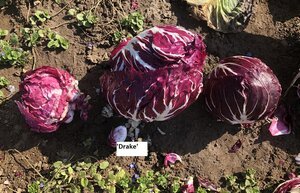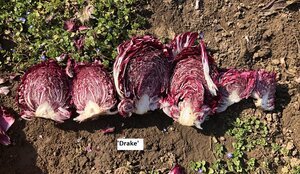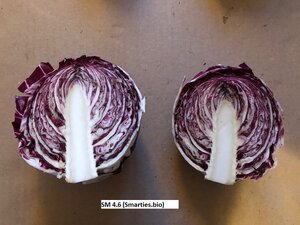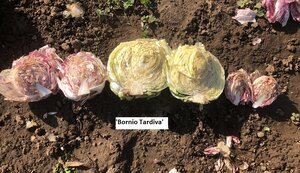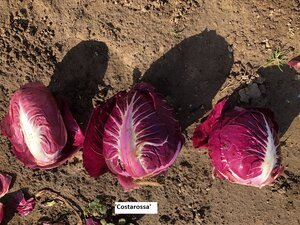Radicchio Variety Information
Rosa Del Veneto Radicchio
Rosa del Veneto is a radicchio very similar in appearance to Rosso di Verona, but bright pink in color, instead of red. The name is an Italian double entendre since ‘rosa’ means both Rose and Pink, and the heads are definitely pink and often shaped like a rose. These amazing radicchio are relative newcomers to the pantheon of Radicchio, apparently discovered in a field of Rosso di Verona, and selected and re-selected to accentuate the pink color.
Rosa del Veneto are less refined than their red cousin, being younger and still, apparently, moving through the awkward tween years. Many heads of Rosa del Veneto are shaped like a squashed football, like Rosso di Verona. Others, have a more open architecture, layers of overlapping leaves open to the sky, more so resembling a rose than a football.
These stunning pink heads are perhaps the most bitter variety of radicchio out there, but because their pink color fades when cooked, Rosa del Veneto are definitely best served raw.
When to Find: January-March
Varieties: Rosalba
Chef Tim Wastell’s Tasting Notes: “vibrantly pink and coral colored”
“When used raw, Rosa’s delicate, crinkled leaves offer only a small fraction of the bitterness with which its cousin is usually associated, making it a delicious and seasonally appropriate stand in for romaine lettuce in Caesar and other popular salads.”
“In high heat applications Rosa’s radiant pink color quickly fades, but it’s seemingly fragile texture shows toothy resilience, and its flavor transforms into a wonderful balance of slightly bittersweet nuttiness and smoky charm. An ideal candidate for ravioli filling, flatbread topping, or a welcome addition to a warm salad of roasted sweet potatoes.”
“Unequivocally vibrant and unique in the realm of winter greens, Rosa Radicchio could be crowned the ‘gateway chicory’ for its sweet, mild flavor and delicate yet resilient texture.”
Variegato Di Castelfranco Radicchio
If Treviso Tardivo is the King of Radicchio, Castelfranco is the queen. Called ‘The Tulip of Winter’ because of its distinct tulip-like shape, variegated Castelfranco is most refined and elegant. There is an old story in the Veneto of a noblewoman from Castelfranco attending a wintertime premier at the Teatro alla Scala in Milan who adorned her gown with a head of Castelfranco radicchio. Everyone believed it was an exotic flower imported from far away.
Castelfranco radicchio have a beautiful tulip-like shape, with an open architecture that resembles a lettuce. The leaves are thin, yet crisp. Like Variegato di Lusia, they start out green with red flecks and become buttery yellow with more red flecks as you move towards the heart. The flavor is mild for a chicory, but still with some lovely radicchio bitterness.
When to Find: November-March
Varieties: SM 4.22, Cecilia, Castellano Tardivo, Castelfranco Franchi
Rosso Di Chioggia Radicchio
Rosso di Chioggia radicchio, often (mistakenly) referred to as simply Radicchio, or Palla Rossa (red ball), are the most commonly known and widely grown type of radicchio in the world. Arriving on the scene relatively recently, these are the type of radicchio you are most likely to find on the shelves of your local grocery store.
Chioggia radicchio are dense, red balls with a relatively thin crunchy leaf that is streaked with white veins. Unlike its red cousins from Treviso and Verona, the ribs and veins on Chioggia are more integrated into the leaf, essentially having the same taste and texture. Often mistaken for cabbage, Chioggia radicchio are anything but. Crunchy, bitter, piquant, and beautiful, Chioggia radicchio are wonderful eaten grilled as well as chopped raw into a salad. Chioggia radicchio are less bitter than Rosso di Verona, but more bitter than Treviso or any of the Green/Yellow varieties.
When to Find: December - March
Varieties: Corelli, Galileo, SM 4.6, SM 4.27, Variegata Marinata, SM 4.8, Rubro, Drake
Chef Tim Wastell’s Tasting Notes:
"In raw applications such as leafy salads, radicchio di Chioggia’s assertive and bitingly bitter flavor was delicious and effective in standing up to and cutting through rich components like anchovies and roasted garlic, as well as balancing sweet ingredients such as roasted winter squash, sliced pink apples or dried persimmons. To tone down the plant’s natural bite before use, I would shredded leaves in ice water for 30-45 minutes to leach out some of its bitterness".”
“When properly cared for, cooked radicchio di Chioggia transforms into something completely magical. High direct heat - especially over wood embers or in an oven on the highest setting - does wonders to alleviate the brash bitterness and replace it with smoky, meaty, and sweet flavors. A knife and fork worthy canvas for the simple addition of good salt, oil and a splash of vinegar or lemon, or as a beautiful addition to pizza or focaccia.”
“Versatile. Radicchio di Chioggia can be a visually beautiful, wonderfully bitter centerpiece or a supporting cast member in both raw and cooked applications, offering balance when raw and deeply savory and sweet characteristics when cooked.”
Variegato Di Lusia Radicchio
Variegato di Lusia is one of the few varieties of radicchio without IGP protections. IGP is the label the European Union gives to vegetable varieties, wine, etc. to indicate that a product is specific to a given region and cannot be marketed under the official title if grown elsewhere. As such, this radicchio is named for the town of Lusia. We also happen to think it’s a particularly pretty group of radicchio.
The heads are round - like Chioggia types - but much less dense. The outer leaves are green and fade to a buttery yellow towards the heart. All of the leaves, both outer and inner, are flecked with red that becomes more pronounced as you go from the outer leaves to the inner. The leaf texture is supple, the most lettuce-like of all radicchio. Variegato di Lusia types are great grilled, sauteed, or served raw.
When to Find: November-February
Varieties: Bornio Tardiva, Adige
Rosso Di Treviso Precoce Radicchio
Treviso Precoce (precoce means early) is the upstart younger sibling to Treviso Tardivo. Whereas, Tardivo requires the ‘imbianchiamento’ or bleaching to achieve its final form, Treviso Precoce does not need to be stored in darkness to develop its deep red leaves and thick, white mid-rib. Treviso Precoce forms a dense, football shaped head in the field. The heads have wine-red leaves and a thick, crunchy white center rib.
Of all the red varieties of radicchio, Treviso Precoce is among the least bitter, second only to Treviso Tardivo. After going through a few frosts, some might even describe the leaves as bitter-sweet. The leaf part retaining bitter characteristics, but the rib developing a pleasant sweetness that offsets the bitter compounds in the leaf.
When to Find: November - January
Varieties: Bottiglione, SM 4.12
Chef Tim Wastell’s Tasting Notes:
“Treviso’s unique (and very functional) shape, mildly bittersweet flavor, and crisp, resilient texture make it an ideal choice for a wide range of raw and cooked applications.”
“When used raw, Treviso’s shape lends itself very well to shredded or slaw type salads, and it plays well against firm textured ingredients such as shaved raw winter squash, celeriac, and beets. Other successful uses included cutting the heads equatorially into rings for chopped style salads and using the whole leaves as boats for handheld appetizers of crudite plates.”
“Treviso’s pervasive sweetness is magnified in cooked applications, and its high moisture content makes high heat scenarios such as wood burning ovens or very hot broilers both forgiving and preferred. Quartered horizontally with the stem intact, it’s hard to find a more durable or delicious roasted chicory.”
“Slower methods, often rightfully overlooked or lost on more delicate chicories, are another encouraged possibility for Treviso. Browning cut sides in olive oil then braising with balsamic vinegar and toasted walnuts, or slowly caramelizing Treviso with red onion into a “jam” are both rewarding and delicious cold weather kitchen activities. Treviso is an antipasti component waiting to happen.”
Rosso Di Verona Radicchio
Rosso di Verona, as a distinct cultivar, is believed to have emerged in the mid- to late-18th century in the farming areas around the city of Verona. Improved breeding techniques in the late-18th and early-19th centuries helped shape the variety to become what it is today, and there is evidence that farmers first started bringing it market by the early 19th century. As with most varieties of radicchio that were grown back then, Rosso di Verona were grown out during the summer, harvested with their roots on, and stored in root cellars for forcing through the winter. Amazingly, when farmers forced Rosso di Verona, they buried their stored plants in holes dug into composting manure piles. The heat from the composting manure triggered the plants to put on new growth, and the darkness accentuated the red color of the leaves and whitened the mid-rib.
Rosso di Verona could be described as the ‘cutest’ of all the varieties of radicchio. Shaped like a squashed football, heads of Rosso di Verona are a deep crimson-red, with a thick, crunchy white mid-rib. The leaves are a somewhat triangular and cup shaped, perfect for filling with a delicious spread. Rosso di Verona radicchio are on the more bitter end of the bitterness spectrum, though as with all radicchio, they get sweeter as the weather gets colder in late-fall and early-winter.
When to Find: December-March
Varieties: SM 4.16, Cologna Tardivo, Costarossa
